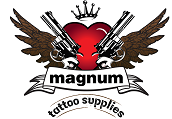Basic Tattoo Materials and Equipment 0
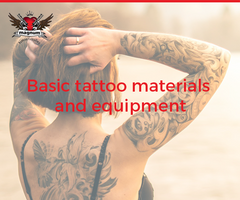
- Flash
The tattoo design or commonly called as “flash” is simply a sketch or a piece of line art that is used to make a tattoo. It can be black, white, or any colour. They are mounted on the walls or displayed in books in the tattoo parlour.
- Stencil
A stencil is just a copy of flash however it is crafted on a special copying paper. The stencil permits the inked outline of the design of the tattoo to be transferred to the client’s skin in order for it to be marked out by the artist.
- Ink
Special inks that are used in order to produce great tattoos are sold by tattoo supply shops. They are usually available in a different kinds of colours and are typically packaged in 4 oz plastic squeeze bottles so they are easily handed out. These inks are liquid dispersions of pigments. They are permitted by the Food and Drug Administration in the United States. The ink is composed of dyes that come from metal components. Due to this reason, allergic reaction to the type of ink used is more likely.
- Tattoo Machine
The tattoo machine is composed of a hand held needle gun attached to a power unit that makes it possible for the pressure to move the needles. The needles can come in different sizes and shapes and are packed jointly on a needle bar in various types of patterns depending on the needs of the artwork. The unit is connected to a power supply that is started by depressing a foot pedal on the floor bedside of the work station. When the pedal is depressed the tattoo needle bar moves up and down quickly. Imagine that of a sewing machine. It makes a way into the skin to inject the dye 3000 times per minute.
- Miscellaneous Supplies
For the whole tattoo procedure the artist may use supplementary supplies like skin disinfectants, petroleum jelly, bandages, razors, and biocidal cleaning supplies.
- Tattoo Removal
Sometimes people with tattoos come to a point in their lives where they decide to have their tattoo removed. Tattoo removal is now possible, thanks to advance technology, however the process is not easy, costly, and sometimes not fully successful. Not so long before, a wire brush was used to rub the skin and wipe out the first and second layers where the ink is present. In order to leach out the ink, salt solutions and acid were used to burn the skin away.
All of these methods are costly, painful, and not very effective. Even though the tattoo can be removed, the affected area may lose its capability to produce normal skin pigment and some scarring will be unavoidable. Today, lasers have been developed to remove tattoos, as it can tear down most of the ink pigment with very little scarring.
Starting a Tattoo Shop: Where should you begin? 0
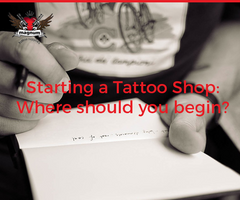
For many years, tattoo arts remain a trendy fashion statement around the globe. It just never goes out of style. Many people are acquiring tattoos and the tattoo industry is steadily on the rise. By doing some researches here and there, opening a tattoo parlour can be a bearable job. Here are some steps to follow in creating a tattoo shop of your own.
Preparation
- Familiarise yourself with the business and acquire proper training. Being a tattoo artist is not really necessary for you to open a tattoo shop. But, a wide understanding about the business is very crucial. If you are a novice tattooist, complete an apprenticeship to ensure that you are properly trained. As a non-practicing shop owner, complete a significant amount of comprehensive research regarding the profession or partner up with an experienced tattooist.
- Go to the nearest local health, city, or municipal department and find out about tattoo business regulations in your area. You should know the laws relating to tattooing and sanitation, although it may vary depending on your location. Your local governing divisions can also direct you to the proper agencies to obtain more information about applying for any required permits and licenses.
- Create a start- up business plan and explore tattoo business software. Your business plan is an important tool and serves as a vision for outlining how much capital is needed to start your tattoo shop, as well as calculating future projections and profit. There are a lot of programs and applications that you can download from the internet to help you create a business plan or you can get assistance from a professional accountant.
- Choose a location that has high traffic. Depending on the type of building you choose, you may have to make some improvements or alterations to accommodate your artists and properly equip the facilities, such as plumbing or electrical outlets.
- Establish an advertising campaign promoting your shop. A strategic marketing is very much needed, especially if you are a beginner, to ensure steady flow of clients. Advertisements such as flyers, social media, TV and radio ads, or even an old-fashioned word of mouth, are great examples of marketing. Plan all of this at least 30 days before opening your shop.
Opening the Tattoo Shop
- Finish and decorate certain areas of the shop. Purchase and install necessary furnishings to accommodate your artists and clients. Work areas need reclining chairs, just like a dentist’s. Lighted tracing tables, supply carts, and large mirrors are also needed. Reception areas, on the other hand, need a counter or desk, chairs, couches, and shelves for display.
- Purchase all required equipment and supplies. Before opening the shop, make sure you are well stocked with all the supplies, materials and equipment needed to properly and efficiently function. Tattooing equipment and supplies typically include an autoclave for sanitising instruments, tattooing machines, needles, ink, paper towels, plastic spray bottles and plastic or latex gloves. Office equipment might include a computer, adding machine, telephones and printers.
- Lastly, hire professional artists to sufficiently staff your studio. The number of artists needed depends on how big your shop is and how much clientele you expect to generate. Prior to opening the shop, evaluate your target clients, prepare hiring staff, and enough professionally trained tattoo artists.
- Matthew Nelson
- Tags: Magnum Tattoo Supplies MTS blog tattoo tattoo artist tattoo artists tattoo blog tattoo shop tattoo tools UK
Top 7 Tattoo Aftercare Products to Try 0
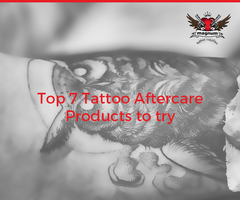
Maintaining the look of your tattoo may seem easy, but just like any other things... tattoos fade after a certain time. This is why manufactures in the tattoo industry came up with tattoo aftercare products to help heal your tattoo while maintaining it's vibrancy.
Here are some of the best tattoo aftercare products for healing, moisturising and enhancing the look of your tattoos.
1. Tattoo Goo original aftercare salve 3/4 Ounce tin
This aftercare product comes from 100% natural ingredients. It is made with herbs, vitamins, and oils known for their healing properties. Using this product allows the skin to breathe and soothe during your tattoo's healing process. Tattoo Goo original aftercare salve is also useful for the skin that is damaged, chapped, scraped and sun or wind burned.
2. Landerm transparent film tattoo aftercare
Landerm transparent film adhesive tattoo dressing keeps your skin away from water, germs and dust while still letting your skin breathe. It is a hypoallergenic adhesive protective barrier designed to speed up recovery of your new tattoo. It's an adhesive dressing that is also light and flexible that provides ultimate comfort. It can also be cut out to adjust to the tattoo size.
3. Ink Fixx tattoo aftercare ointment
Ink Fixx Tattoo aftercare ointment is one of the highest rated tattoo aftercare product on Amazon. It contains all of the necessary vitamins and minerals needed to allow the tattoo to heal fast and naturally. This ointment should be applied daily for your tattoo to avoid cracking, scabbing, or peeling. It also helps to avoid your tattoo’s colour to fade. It is completely based on natural ingredients, making it gentle on skin.
4. Tattoo Goo’s tattoo Kit
Getting the whole kit gives you a great deal. With an affordable price, this tattoo aftercare kit consists of five different products made by Tattoo Goo. Among these five aftercare products are moisturising lotion, soap, ointment, and a lot more. The kit is proven to be one of the best products that can heal your new tattoo. You can use it as skin moisturiser, tattoo healer, soother and infection preventer.
5. H2Ocean Extreme tattoo care kit
This product is one of the most recommended tattoo aftercare products by tattoo professionals worldwide. The 3- step ointment based system is known for its first aid healing process. Just like any other aftercare product, it keeps and protects the colour of your tattoo for a long time.
6. After Inked Tattoo Moisturiser and aftercare lotion
After Inked product is made to moisten your new and existing tattoo. This all- natural product helps your tattoo look and feel healthier. It is also non-petroleum based, paraben-free, fragrance-free, vegan, cruelty-free and gluten-free. This clinically- tested product is safe on all skin types, and is non- irritant.
7. A&D Ointment Element tattoo aftercare medical supply
Inside the package are 144 individual packs. It is used during the tattooing process as a skin moisturiser but it can also be used as a tattoo aftercare lubricant / moisturiser.
Things you should know about Tattoo Anaesthetics 0
 Most people get addicted to getting tattoos because of the pain they feel during the tattoo process. Others want to get a tattoo to overcome emotional pain and divert it to physical pain. But not everyone wants to get a tattoo and feel the needle penetrate their skin. Some even doubt themselves whether they can handle the pain or not. Fortunately, tattoo product manufacturers have come up with a solution to cater to those who are dying to get a tattoo but have low pain tolerance. There are tattoo anaesthetic sprays, numbing creams, and anaesthetic gels available on the market. Tattoo artists have been using these anaesthetics for a long time.
Most people get addicted to getting tattoos because of the pain they feel during the tattoo process. Others want to get a tattoo to overcome emotional pain and divert it to physical pain. But not everyone wants to get a tattoo and feel the needle penetrate their skin. Some even doubt themselves whether they can handle the pain or not. Fortunately, tattoo product manufacturers have come up with a solution to cater to those who are dying to get a tattoo but have low pain tolerance. There are tattoo anaesthetic sprays, numbing creams, and anaesthetic gels available on the market. Tattoo artists have been using these anaesthetics for a long time.
There have been a lot of questions and speculations about these tattoo anaesthetics. And we would like to answer some of those questions for you and for others who are scared to get a tattoo because of their low tolerance to pain.
- Do tattoo anaesthetics really work? Yes, of course! These products can be very effective. However, not all anaesthetics are created equally. If you own a tattoo shop, and you want to offer tattoo anaesthetics to your client, be sure to look for the following ingredients when buying tattoo anaesthetics: lidocaine, tetracine, benzocaine, and/or epinephrine. Menthol, camphor, tea tree oil, and comphrey roots are some of the natural additives that help enhance the power of the anaesthetics.
-
How do they work? Lidocaine, one of the numbing agents mentioned earlier, can be found in nearly every tattoo anaesthetic product. The higher the percentage of lidocaine, the more effective it will be. It deadens the nerve endings and makes the tattooing process more comfortable for both the artist and the customer. Also, lidocaine is a key ingredient in reducing the initial stings of a tattoo needle when it hits the skin. It prevents the client from flinching too much. There are also products that contain tetracine or benzocaine, if not both. These are nerve blockers.
They do not totally put a stop to nerves from sending pain signals to the brain, but they lessen the level of discomfort that those pain signals can give. There's also, epinephrine, a vasoconstrictor that causes the blood vessels to narrow. This narrowing means there is less bleeding and swelling during the tattooing process. However, be careful as too much of these anaesthetics can cause complications.
- What is the most effective combination of tattoo anaesthetics? Some tattoo anaesthetics take effect faster than others, which makes them perfect as boosters to apply as secondary layers throughout the whole tattooing process. When you are using a tattoo anaesthetic that contains epinephrine, it won't be necessary to reapply it, one layer is enough. Also, try to use tattoo anaesthetics like Tattoo Soothe Cream or Hush anaesthetic gel. During the preparation of the skin for the tattooing process, wash client’s skin with products like H2Ocean’s Nothing Pain-Relieving Foam Soap enhanced with Bactine. The Bactine will help in reinforcing the effects of any topical anaesthetic applied beforehand.
- Matthew Nelson
- Tags: blog Magnum Tattoo Supplies Magnum Tattoo Supplies blog Manchester MTS blog Tattoo Anaesthetics UK
Tattoo Tools: Autoclavable or Disposable? 0
 Being a tattoo artist means being responsible for your client’s safety and satisfaction. One of the things a tattoo artist considers before starting their own tattoo business is whether to use autoclavable tools or disposable ones. Tattoo tubes, tips and grips are essential components in every tattoo artist's toolkit, so it's important to choose carefully and pick supplies that are economical without sacrificing quality.
Being a tattoo artist means being responsible for your client’s safety and satisfaction. One of the things a tattoo artist considers before starting their own tattoo business is whether to use autoclavable tools or disposable ones. Tattoo tubes, tips and grips are essential components in every tattoo artist's toolkit, so it's important to choose carefully and pick supplies that are economical without sacrificing quality. Pros and Cons of Autoclavable and Disposable Tattoo Tubes, Tips and Grips
Once you know all the pros and cons, you will have a better idea on whether to choose disposable or autoclavable tips, tubes and grips.
When purchasing disposable types, everything comes in a package, including the grip, tube, and tip. On the other hand, autoclavable tools are often sold separately. Buying tools separately might sound like a burden, but it can actually be a beneficial. There are actually several benefits in purchasing reusable tattoo grips, tips and tubes separately that may outweigh the convenience of all-in-one disposable units. The difference between an autoclave and disposable type are pointed out below.
- Minimal Equipment Needed
- The Cost Factor
- Customizability
Before you start narrowing down your options, you need to know what your choices are as well as the benefits and drawbacks of each option. I hope the comparison I've shared above helps you determine which one will work best for you.
Tattoo Inks and its effects on skin 0
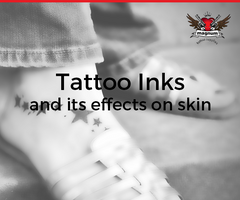
They say wear your heart on your sleeve, but other people choose to wear it on their skin. For some, tattoos are a way of expressing a part of who they are. Aside from that, tattoo is a great form of art. Having a tattoo may not be everyone’s cup of tea because of the risks that come with it. With so much articles written online, it's pretty confusing which ones to take seriously. One of the commonly discussed factor that scares most people who haven't had a tattoo is the ink and the components used to create it.
Tattoo ink is a liquid that contains one or more colourants and other ingredients in the form of adjuvants, such as binding agents, additives and solvents. It is abundant of different chemicals. This is why every tattoo ink is different and might have different effects on the skin. If you get two tattoos in the exact shade, but get them at different times and from different artists who use different inks the chemical compositions probably won’t match. Tattoo inks include pigments, which can contain a variety of metallic salts, like oxides, selenides, sulfides, organic dyes, or plastics, and the carriers with which they are mixed to help provide an even application of the ink.
Inks are usually either alcohol-based or water-based. It may include ethanol, methanol, and glycerin products as mediums for transferring the pigments in the inks. Below are some of the benefits that these types of tattoo inks contain.
- Non- toxic inks
Non- toxic inks are made from organic pigments. It has been developed recently, after certain chemicals previously used to make traditional tattoo inks were linked to cancer. This type of tattoo ink is different since their pigments are all made from ingredients that come straight from nature.
- Water based tattoo inks
Water- based inks produce flexible, dynamic pigments in reliably bold, beautiful colours.
- Vegan tattoo ink
Another type of tattoo ink that is now popular to the majority is the vegan tattoo ink. These inks don’t use any type animal by-products for colour or carrier solutions. Using a vegan tattoo ink is beneficial because it lasts longer compared to regular inks. The ink does not contain chemicals that are harmful for your skin, and for your tattoo artist's health. Research also shows that tattoos with vegan and non-toxic inks have faster healing time because of it's natural ingredients.
- Glow in the dark and backlight tattoo ink
Both inks have been used for tattooing. Glow in the dark ink absorbs and retains light and glows in darkened conditions by the process called phosphorescence. Blacklight ink does not glow in the dark, but reacts to non-visible UV light, which produces a visible glow by fluorescence.
- Black henna
Black henna is normally applied externally for temporary “Mehandi” tattoos, rather than being injected beneath the skin as a permanent tattoo. It is a temporary tattoo that has an ingredients that can also be found on hair dyes.
